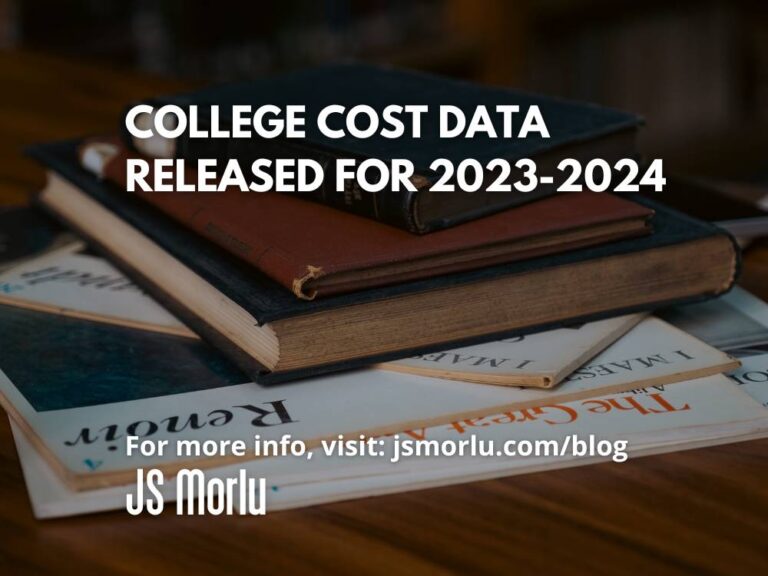Every year, the College Board releases new college cost data and trends in its annual report. The figures published are average cost figures based on a survey of approximately 4,000 colleges across the country.
Over the past 20 years, the average price for tuition, fees, and room and board has increased 38% at public colleges and 29% at private colleges over and above increases in the Consumer Price Index, straining the budgets of many families and leading to widespread student debt.
Here Are College Cost Data Highlights for the 2023–2024 Year
Public four-year: in-state
- Tuition and fees increased 2.5% to $11,260
- Housing and food (formerly room and board) increased 3.7% to $12,770
- Total cost of attendance*: $28,840
Public four-year: out-of-state
- Tuition and fees increased 3.0% to $29,150
- Housing and food increased 3.7% to $12,770 (same as in-state)
- Total cost of attendance*: $46,730
Private four-year
- Tuition and fees increased 4.0% to $41,540
- Housing and food increased 4.4% to $14,650
- Total cost of attendance*: $60,420
*Total cost of attendance includes direct billed costs for tuition, fees, housing, and food, plus indirect costs for books, transportation, and personal expenses. Many private colleges are at or approaching $80,000 per year in total costs.
Sticker Price vs. Net Price
The College Board’s cost figures are based on published college sticker prices. But many families don’t pay the full sticker price. A net price calculator, available on every college website, can help families see beyond a college’s sticker price. It can be a very useful tool for students who are currently researching and/or applying to colleges.
A net price calculator provides an estimate of how much grant aid a student might be eligible for at a particular college based on the student’s financial information and academic record, giving families an estimate of what their out-of-pocket cost — or net price — will be. The results aren’t a guarantee of grant aid, but they are meant to give as accurate a picture as possible.
Student Loan Payments Resumed in October
Student loan payments resumed in October 2023 for millions of federal student loan borrowers after almost three-and-a-half years of payment pauses. In connection with the restart of payments, the Department of Education launched a new income-driven repayment (IDR) plan called Saving on a Valuable Education, or SAVE. The SAVE Plan, the most generous to date, includes multiple new benefits for borrowers, some of which take effect now and others that are scheduled to take effect in July 2024 when the plan is fully implemented, including monthly payments that are capped at 5% of discretionary income for undergraduate loans and at 10% of discretionary income for graduate loans.
Federal student loan interest rates for the 2023–2024 school year are the highest they’ve been in years: 5.50% for undergraduate Direct Loans, 7.05% for graduate Direct Loans, and 8.05% for graduate and parent Direct PLUS Loans.
2024–2025 FAFSA Delayed Until December
Typically, the Free Application for Federal Student Aid, commonly known as the FAFSA, opens on October 1 for the upcoming school year. This year, however, the 2024–2025 FAFSA has been delayed until December due to the most significant overhaul in decades.
The new, much shorter FAFSA contains a number of changes, including:
- A new “student aid index” (SAI) will replace the current “expected family contribution” (EFC) terminology in an effort to frame the resulting figure as a yardstick measuring a student’s financial aid eligibility, rather than what a family will pay.
- For parents with multiple children in college at the same time, the new FAFSA will no longer provide an advantage in the form of a reduced parent contribution. This change has the potential to significantly decrease aid eligibility for middle- and high-income students who have one or more siblings in college.
- Cash support and other money paid on a student’s behalf, for example a gift of money from a relative or a distribution from a grandparent-owned 529 plan, will no longer need to be reported on the FAFSA.
Remember that the 2024–2025 FAFSA will rely on income information from two years prior on your 2022 federal tax return (referred to as the “base year” or the “prior-prior year”) but will use current asset information as of the date you submit the form.
JS Morlu LLC is a top-tier accounting firm based in Woodbridge, Virginia, with a team of highly experienced and qualified CPAs and business advisors. We are dedicated to providing comprehensive accounting, tax, and business advisory services to clients throughout the Washington, D.C. Metro Area and the surrounding regions. With over a decade of experience, we have cultivated a deep understanding of our clients’ needs and aspirations. We recognize that our clients seek more than just value-added accounting services; they seek a trusted partner who can guide them towards achieving their business goals and personal financial well-being.
Talk to us || What our clients says about us


